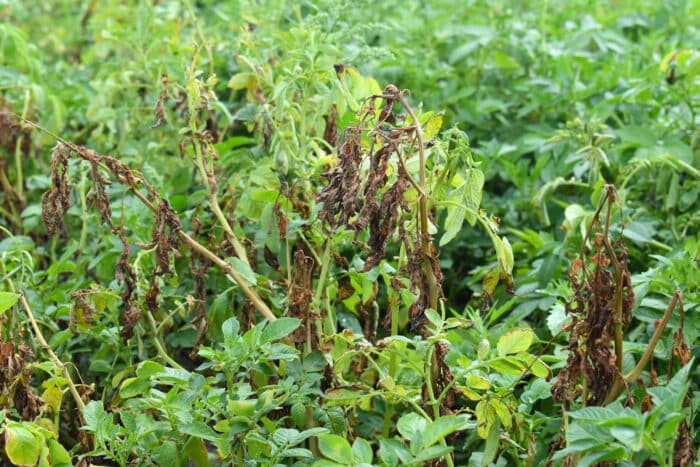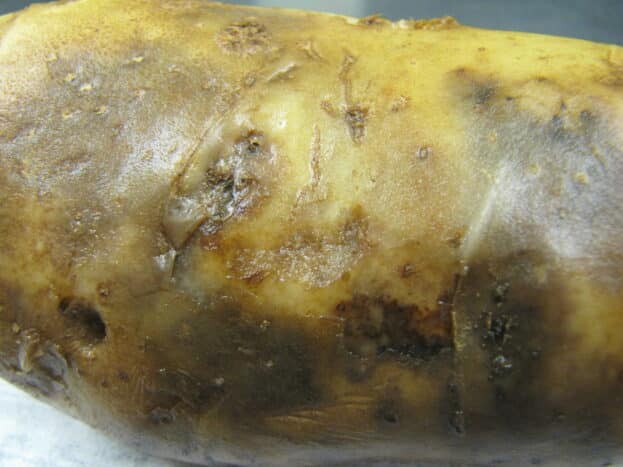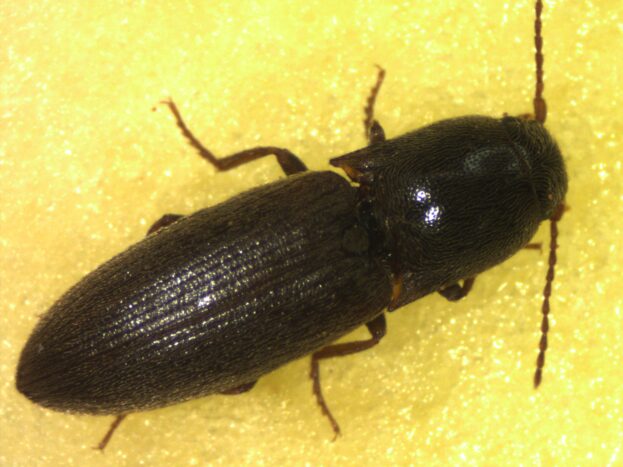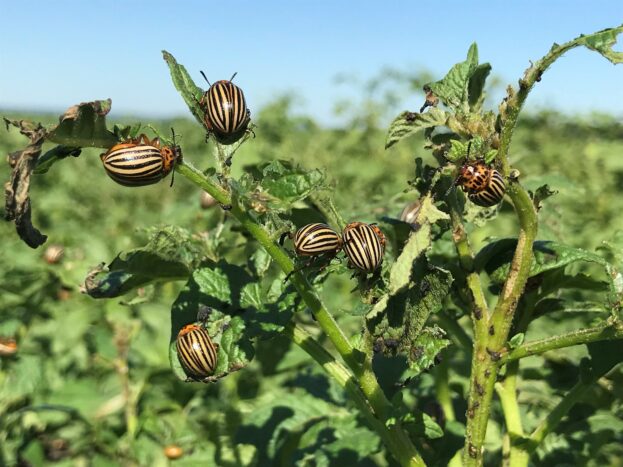What’s hot, what’s not for 2023 when it comes to potato pests and diseases from coast to coast for the 2023 growing season.
Potato farmers from coast to coast have a lot to contend with between diseases and pests. Certain regions are hit harder than others and where you farm will shape how you approach 2023 regarding both issues. With spring planting right around the corner, Spud Smart rounded up voices from the top scientists from across the country to let you know when to fret about it and when to forget about it.
New Brunswick
Monitoring crops for Potato Virus Y (PVY) and it will be essential to use both oils and insecticide. “Insecticides alone will not stop the spread of the virus via aphid vectors,” says Khalil Al-Mughrabi, a pathologist at the Potato Development Centre in Wicklow, N.B.
Similar, he notes that Potato Early Dying (PED) — which is becoming more frequent in New Brunswick and all across Canada — requires multi-pronged management of healthy seed and soil treatments with both a fungicide and nematicide. Currently, a national research program is about to conclude a PED multi-year study of the various efficacy levels of products on PED. A final report will be released no later than the fall.

Depending how winter played out in your particular fields will determine the relative level of inoculum in the soil.
The province hasn’t recorded an official case late blight since 2017. This is all because of low inoculum, unfavourable weather conditions for disease development and best management practices that are being adhered to closely. Even though Quebec and Ontario had late blight in 2022, it didn’t make its way to New Brunswick.
A nationally co-ordinated late blight project between British Columbia, Manitoba, New Brunswick and Prince Edward Island continues to focus on tracking the distribution of late blight pathogens.
“A continued understanding of the prevalence and characteristics of pathogen strains will be critical for successful disease management,” he says.

The good news is that US-23, the most common strain of late blight, is still controlled by current fungicide groups, although Ridomil has proven ineffective in certain strains. Something else to keep an eye on is late blight in the face of climate change.
“Some of the newer strains have adapted to infect and reproduce at warmer temperatures which may be one reason they are becoming more common,” says Al-Mughrabi.
Similarly, early blight has made inroads due to climate change, as well, says Al-Mughrabi. Rapid shifts between hot and wet weather stress the foliage, causing susceptibility to increase. It’s something Al-Mughrabi is hearing more of across all Canadian growing regions.
For pests, he notes that Colorado potato beetle (CPB) are still a major concern in Canada and New Brunswick. Due to increasing insecticide resistance, Al-Mughrabi recommends farmers switch between various modes of action. Regionally, the Maritimes, and New Brunswick especially, have been rocked by aphids, especially in July and August 2022, with numbers doubling the year prior. Speculation is that climate change played a major role in the shift, explains Al-Mughrabi.
“Excessive windstorms might have carried the aphids from the States,” he says. “Exceptionally warm weather might have affected the lifecycle of the green peach aphid and increased its population in potato fields.”
Just like PVY, oils and insecticide in tandem are the official recommendation.
Prince Edward Island
After a fantastic 2022 full of high yields and excellent qualities spuds, Island potato industry co-ordinator Lorraine MacKinnon expects 2023 to be no different.
“With regards to insects and disease, we are expecting and certainly hoping for a similar year in 2023,” she says. Certainly, for this year everyone is going to be keeping a keen eye on aphid populations which upticked substantially in the late stages of the 2022 growing season.
Mackinnon definitely urges farmers to be vigilant regarding aphid watching, which could lead to PVY becoming a huge issue.
“We are maintaining our three per cent virus cap for potatoes being planted and reminding growers of the best management practices that have been developed for managing both PVY and aphids,” she says. With last year’s detection of late blight spores, MacKinnon says industry will be closely watching as well. Beyond that, usual pathogens such as botrytis, early blight, brown spot, verticillium, late blight can all be managed with well-known BMPs related to said pathogens.
She also encourages farmers to use proper handling techniques of tubers both at harvest and subsequent planting as severe infestation rates can lead to poor emergence rates.
The best way to monitor late blight is with spore traps and weather modelling. So, even when it was discovered in a few pockets, everyone was already prepared.
“Growers maintained diligence with control measures, and we didn’t see any field infections,” she says.
“Bacterial soft rots can also impact emergence but are mainly either secondary to other tuber diseases (such as fusarium); or are brought on by favourable soil and weather conditions,” explains MacKinnon.
Depending on the weather in 2023 for Island farmers, dry weather will mean to watch for pathogens to watch for will be alternaria or PED, but if it’s wet, watch for botrytis and white mold.

The government’ three-year click beetle survey results were released Feb. 13 during the P.E.I. Potato Conference. In short, populations are shrinking. A firm commitment to crop rotation has reduced the beetle to negligible levels. Combine that with a new insecticide that hit the market two years ago and farmers are back on top.
Corn borer and flea beetle are also of no concern at the moment.
Everyone continues to talk about potato wart, and for good reason. After one of the worst years thanks to a closed U.S. market, Island farmers are poised to bounce back with co-operation from all levels of government working to support P.E.I. farmers.
“This has been a very difficult issue for P.E.I. potato growers,” says MacKinnon. A recent report by an international advisory panel states that the management of potato wart on P.E.I. has been effective and follows international standards, that the pathogen is present however, is not widely distributed and under official control.
“They have also provided some recommendations on the development of pest free areas or places of pest free production to enable the movement of seed,” she says. “The province is working with industry and the federal government to move forward with these recommendations as efficiently as possible.”
Other seedborne diseases which will likely appear in at least some fields include blackleg, Fusarium, common scab and soft rot, all of which carry well-established control methods.
Manitoba
Most Manitoba potato farmers will need to keep an eye on aphids and late blight, and depending on where you operate, CPBs, and potato early dying caused by verticillium wilt and black dot diseases, according to Vikram Bisht, a pathologist for potato and horticulture crops for the Manitoba government.
“I expect we will continue to have late blight as our disease of concern,” he says. “Even though it’s not present in our vicinity, there were areas where the spores were trapped but late blight disease was not reported in the field.”
Bisht also notes that in B.C. there were documented late blight cases and that could be problematic for Manitoba if infected seed is sent to the province for market gardens or seed sales.
Manitoba hasn’t had strong levels of the disease for the last few years, yet it’s still the No. 1 concern because of how fast it can do damage, not only in the field. “It can lead to significant losses due to a lot of secondary rotting, poor storability and quality issues” he says.
Tight rotations are always at a greater risk of running into verticillium wilt, and he expects this year to be no different. Most growers go for longer rotations in affected fields and there are certain varieties which are more tolerant to the impacts of disease. Many growers, he says, also try to manage it with fumigation, either chemical or biological based agents, including mustard, the latter of which is being tested on a large scale to see if commercial adoption has merit.
Like other provinces, Bisht notes that aphids will likely be an issue, specifically for seed potato growers, it just depends on the severity. In 2022, Manitoba had a surge of total aphids in seed potato fields, but green peach aphid and Potato aphid were low. Overall numbers were much lower compared to Atlantic Canada.
“We’ve had some seed lots which are showing some levels of Potato Virus Y infection; it can be an issue especially when the seed crop and the commercial crop are grown close by and aphid populations can move the disease from the infected lots to the clean fields,” he explains.

With CPBs, although they are a concern in some localized areas, populations are well managed in most of Manitoba with insecticide seed treatment alone or with added single foliar spray. However, there are increasing numbers that are becoming resistant to certain insecticides, despite the overall population being manageable.
His words of wisdom aren’t anything brand new, but it bears repeating: “Get good quality seed, look at the disease forecasts and work very well with your agronomist so they can monitor the crop for you and use good recommendations,” says Bisht.
Ontario
Ontario has had a somewhat mild winter compared to other years. As such, this could see a rise in volunteers and subsequently late blight, warns Dennis Van Dyk, vegetable specialist with the Ontario Ministry of Agriculture, Food and Rural Affairs (OMAFRA).
“The mild winter makes me weary about potential for late blight to take off, despite there not being huge levels of inoculum around,” he says. “Getting late blight on volunteers in rotational crops is probably the main concern at this point with a mild winter. We didn’t have a lot of late blight pressure last year, but you never know what can come up in the season, what comes in on the seed, what gets blown in early season.”
Van Dyk recommends spore trap monitoring to catch spores and use it as an early warning system in combination with field scouting.
Van Dyk also wants farmers to watch out for early blight caused by alternaria, which is a common pathogen across Ontario and has shown signs of resistance to regularly used fungicides. Another key issue is scab, which is particularly difficult to fight against because there are limited options to control it. The top recommendation he offers is to constantly be looking for new varieties that carry strong tolerance ratings towards the disease.
With pests, CPBs are top-of-mind for Ontario potato growers, according to Van Dyk. Still, neonic-treated seed or treatments in-furrow seem to be working well. While there’s some level of growing insecticide resistance found in Ontario fields, there are enough rotational options available that farmers are still having success. Beyond that, aphids and leaf hoppers are pests of concern, as well.
Alberta
The good news for Alberta potato farmers is that their list of worries is decidedly shorter than other provinces. This is according to Dmytro Yevtushenko, associate professor in the department of biological sciences at the University of Lethbridge, and head of the Potato Research Lab.
Diseases farmers should watch for include Verticillium/early dying complex, common and powdery scab, and blackleg. This winter in Alberta was mild compared to other years, so growers will have to wait and see what the situation is like come springtime; some diseases could rebound at greater levels.

Alberta farmers contend with fewer diseases due to the long crop rotations they employ, anywhere between five to seven years, which are among the best in the industry, notes Yevtushenko. Not only are these practices highly beneficial to soil fertility, but they significantly reduce viability of primary inoculum of soilborne pathogens.
For certain provinces, late blight’s a serious issue. Luckily, the mostly dry and hot summers of Alberta do not favour late blight disease development. Additionally, the province has a strong Potato Pest Monitoring program, notes Yevtushenko. This early detection and diagnostics system is designed to help potato growers to improve disease management decisions and involves close collaboration between the University of Lethbridge, Promax Agronomy Services Ltd., the Potato Growers of Alberta, and field owners. The program runs from June to the beginning of September, and uses a network of sophisticated, solar-powered automatic spore traps that suck in spores like a vacuum. The university students carefully examine the trapped spores under microscope for morphological features that are characteristic to Phytophthora infestans.
“For the past four years, the number of Phytophthora spores has never exceeded the threshold,” says Yevtushenko.
They monitor alternaria and fusarium spores as well, which are causative agents for early blight and Fusarium wilt, respectively. As a result, early blight is not on the radar for Alberta farmers this year but is closely monitored.
Yevtushenko says fusarium dry rot is almost inevitable as farmers hold onto their potatoes for eight months or so until early June. The same is true for soft rot and pink rot, although it is not officially classified as a big issue in 2023.
One issue he is concerned about is the recently observed relatively high number of potato psyllids compared with past two years. This coincides with general fluctuations in insect populations. The challenge is, however, that potato psyllids may carry a bacterium (Lso) that causes zebra chip disease, revealed in affected fried tubers as distinct brown discoloration resulting in “striped potatoes.” Potato zebra chip disease is currently absent in Canada but presents serious economic threat to the industry. “This disease is relatively new and was found in southern regions of the U.S.,” he says. “With a warming climate, pathogen-carrying psyllids may move a great deal north.”
Currently, university students analyze insect sticky cards for the occurrence of potato psyllids in local potato fields and perform molecular tests to determine the presence of zebra chip bacteria but have found none.
With minimal pest issues, Yevtushenko says the storylines of 2023 issues for potato farmers will presumably relate to diseases, but he does remind growers to continue to monitor for insects, and spray when necessary to ensure they do not become vectors to transfer viruses.
Related Articles
Mustard 21 is Bringing Back Mustard for Biofumigation
A New Disease Called Rubbery Rot is Lurking in Potato Storages
Top Contenders for Potato Pests and Diseases Across Canada for 2022








